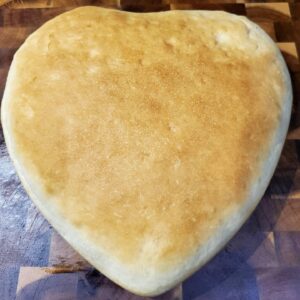
Bread making in North America became popular during the COVID pandemic. Droves of home chefs re-entered their kitchens to hone in on a skill that once seemed lost and made exclusive only to professional bakers. It was perhaps the calming aspect of bread making that popularized this culinary activity. The act of rolling, kneading, and mixing, all seemed to force presence of mind and being in the moment, helping disenfranchised individuals to manage and cope with the uncertainty of life and conjure up positive feelings that calmed the spirit. Besides, baking bread at home reduced the need to make trips to the grocery store, which became a stressful activity, during this season. In short, baking bread became a culinary therapeutic tool for the COVID pandemic life.
Bread making in ancient times was also significant. It represented a pivotal time in the evolution of man as it emerged during the period when humans were no longer nomads but started to settle down in specific regions and focused on growing a variety of crops to sustain life. Wheat and grains became one such crop, which consequently became domesticated and a staple. Once there was a large variety and availability in abundance, these grains were milled into flour as a form of preservation and subsequently used to make bread.
There is extensive evidence of breadmaking activities in antiquity in the form of artistic depictions on ancient structures that are still standing and stories documented in ancient books, such as the bible, that details the consumption of bread as a focus. The most common bread of ancient times was leavened bread. Leavened bread is simply bread made with a leavening agent, or an ingredient that will make the bread rise. The use of such an agent gives the bread volume, a lighter, airier texture, and a crumb factor. Examples of leavening agents include yeast, baking powder, baking soda and air. It is interesting to note that the leavening agent used in antiquity consisted of day-old bread dough mixed with sugar and water or a fermented paste made from grape must (freshly crushed grape juice containing the skin, seeds, and stems of the grape) and flour. These flour-based mixtures became the precursors of the modern-day sourdough starter.
There is a large variety of breads that use raising agents. Examples of such leavened breads include sourdough bread, a bread with ancient roots made by a long fermentation process using yeast; corn bread, an American bread originating in the South and made with cornmeal, wheat flour and milk; naan, a flatbread heavily incorporated into Indian cuisine and made of flour and yeast; ciabatta, an Italian bread that is light and airy with a chewy crust and made with high-gluten flour, yeast and water; baguette, an iconic French bread known for its long narrow shape and made of whole wheat flour; challah, a traditional Jewish bread that is distinguished by its three-strand braid, eaten during special occasions and made of flour, sugar, oil, eggs and yeast; soda bread, originating in Ireland, classified as a quick bread because it doesn’t require any rising time and is typically made with wheat flour, buttermilk and baking soda; and pumpernickel bread, a dark dense German rye bread that has an intense flavor and a unique taste because of the rye flour used to make it.
Unleavened breads are typically any bread that is made without using a leavening agent. For this type of bread, the dough is not allowed to rise, resulting in a flat and more dense bread. Unleavened breads are eaten in a variety of cultures and utilized in many traditional religious practices. Examples of unleavened breads include tortilla, a thin flatbread typically made of corn or wheat and considered a staple in South and Central American cultures; roti, a round flatbread made from whole wheat flour and utilized in a variety of South Asian dishes; chapati, a bread originating in India but now heavily incorporated in Middle Eastern and African cuisines and typically prepared using wheat flour, sugar and water; and Lavash, a cracker like flatbread with culture roots in Armenia, Iran and the Middle East.
Breads have become a staple on the tables of just about every culture in the world today. The variety of flavors and tastes add dimensions to the unique dishes that they are typically paired with. The awesome thing about breads is that most are naturally vegan, with the exception of a few that contain eggs. These can be easily remedied to veganize them by utilizing plant-based substitutes. This week I am sharing a recipe of one of family’s favorite breads, which is also an all-time Southern favorite, vegan cornbread. This recipe gives you light, fluffy cornbread that comes out perfect every single time. Happy cooking!
Golden Vegan Cornbread
Ingredients
- 1 ¼ cups all-purpose flour
- 1 cup yellow corn meal
- 1 2/3 cup brown sugar
- 1 teaspoon salt
- 1 tablespoon baking powder
- ½ teaspoon baking soda
- 1 teaspoon cinnamon powder
- ½ teaspoon nutmeg
- 1 teaspoon vanilla
- 1 ¼ cup unsweetened almond milk
- 1/3 cup avocado oil
Directions
Preheat the oven to 400 degrees F and lightly grease an 8” x 8” pan, 9” round cake pan, or, 12-count muffin pan. In a large bowl, combine the flour, cornmeal, sugar, salt and baking powder, baking soda, cinnamon powder, nutmeg and stir. Pour in the milk, vanilla and avocado oil. Stir until well combined. Pour batter into the prepared pan. Bake for 20-25 minutes, until a toothpick inserted into the center comes out clean. For muffins, reduce bake time to 15-18 minutes. Pair with your favorite stew or chili and enjoy!
Previously published on Sunday October 9, 2023 in the monitortribune.com
